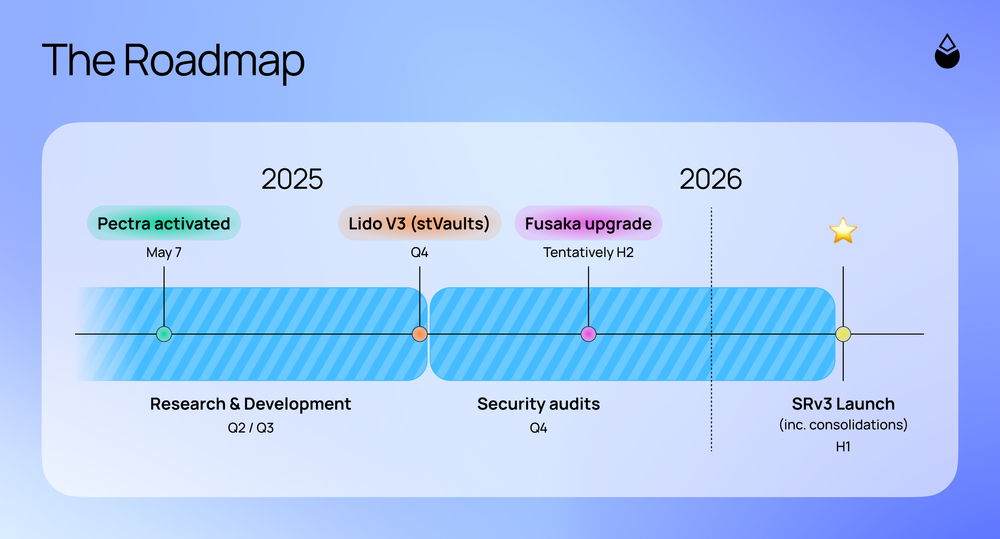Lido’s Game-Changing Validator Upgrade SRv3 Set to Launch in 2026
Lido just dropped a bombshell—its long-awaited SRv3 validator upgrade is locked in for 2026. This isn’t just an update; it’s a full-scale reinvention of staking infrastructure.
Why TradFi Should Be Nervous
The upgrade slashes legacy validator inefficiencies while boosting scalability. Think of it as DeFi’s answer to Wall Street’s creaky settlement systems—except it actually works.
The Timeline Play
2026 might seem distant, but in crypto years? That’s basically tomorrow. Lido’s playing the long game while competitors scramble to keep up.
One hedge fund manager already called it "unnecessary innovation." Translation: they’re terrified of yield they can’t middleman.

- Lido is rolling out validator consolidations with SRv3 in the first half of 2026.
- The shift introduces a new accounting model to support larger validators.
- Node Operators will benefit from lower costs and easier management.
Lido DAO is gearing up for a major technical shift following Ethereum’s Pectra hard fork that went live on May 7, 2025. One key change from this upgrade, known as EIP-7251, allows validators to manage more than the old 32 ETH cap.
For Lido, this opens the door to consolidate multiple validators into larger units, cutting down on network load and improving rewards slightly. While the risk of slashing or node failure remains low, faster response times will become even more important.
Lido’s Roadmap to Pectra, Part 3
Ethereum, Lido and optimising staking economics with validator consolidations.https://t.co/7ut5r4l3wU pic.twitter.com/eWv05wzwBD
To support this, the network is planning a two-phase rollout, starting with its upcoming V3 update. The new changes will be built on top of the Staking Router, which already serves as the Core coordination system for it.
It connects deposit flows to various modules that make up the protocol’s staking structure. Introduced in 2024 with SRv2, the Router replaced Lido’s older model with a more flexible setup that now includes Curated, Community Staking, and SimpleDVT modules.
The network’s shift toward validator consolidation is more than just technical housekeeping. It’s a key part of the project’s plan to stay aligned with Ethereum’s evolving structure while also keeping its own network strong and efficient.
Also Read: Lido DAO (LDO) Surges in Staking Fees, Eyes Breakout Amidst Analyst’s Bullish Prediction
Lido Prepares SRv3 Upgrade to Revolutionize Staking Architecture
The network is now working on the third version of its Staking Router, SRv3. This new version is expected to go live in early to mid-2026 and will include support for large validators and validator consolidation. But it’s more than just a software update.
SRv3 introduces a balance-based accounting system, letting Lido treat validators as flexible balances rather than fixed 32 ETH units. This makes it easier to merge validators and scale operations.
Right now, the protocol tracks validator activity using a unit-based system. Shifting to a balance-based approach means major updates are needed across how the network handles deposits, withdrawals, and reward distribution. But the payoff is worth it, more flexibility, better efficiency, and a smoother user experience.
The network also plans to roll out direct deposits with SRv3. This means new stake can be routed straight into validators through the protocol. At first, this option will be available only to approved actors, but it may expand in the future.
Consolidations will be handled through EasyTrack, a tool already used by Lido for on-chain governance. It allows quick and secure decisions without slowing down the network, making it the perfect fit for this next step.
SRv3 Upgrade Aims to Boost Efficiency and Flexibility on Lido
Alongside consolidations and direct deposits, SRv3 sets the stage for a more advanced stake allocation system. This will allow the network to spread stake more strategically, based on performance and risk factors. Similar ideas have already been tested in the Community Staking Module v2, and now they’re being scaled to the CORE of the protocol.

Validator consolidation remains the top priority, followed by streamlining new stake deposits and designing smarter allocation rules. These upgrades aim to make Lido more resilient, lower costs for operators, and reduce concentration risk across the network.
With development already underway, the full rollout of SRv3 marks a big step toward a more efficient, secure, and future-ready Lido staking platform.

